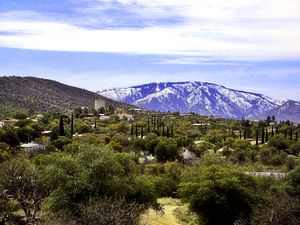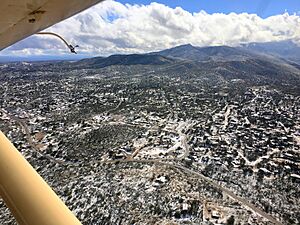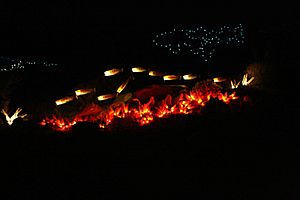Oracle, Arizona facts for kids
Quick facts for kids
Oracle, Arizona
|
|
|---|---|

Acadia Ranch Museum
|
|
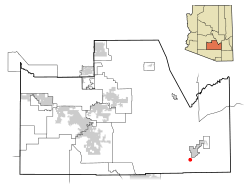
Location in Pinal County and the state of Arizona
|
|
| Country | United States |
| State | Arizona |
| County | Pinal |
| Area | |
| • Total | 15.87 sq mi (41.10 km2) |
| • Land | 15.87 sq mi (41.10 km2) |
| • Water | 0.00 sq mi (0.00 km2) |
| Elevation | 4,524 ft (1,379 m) |
| Population
(2020)
|
|
| • Total | 3,051 |
| • Density | 192.29/sq mi (74.24/km2) |
| Time zone | UTC-7 (MST (no DST)) |
| ZIP code |
85623
|
| Area code(s) | 520 |
| FIPS code | 04-51180 |
| GNIS feature ID | 32541 |
Oracle is a small community in Pinal County, Arizona, United States. It's called a census-designated place (CDP), which means it's a community that isn't officially a city or town but is recognized for census purposes. In 2020, about 3,051 people lived there.
Oracle is located near Oracle State Park, a beautiful natural area. The famous Arizona Trail, a long path for hiking and biking, goes right through the park and the community.
Oracle is also known as the starting point for a road leading up Mount Lemmon. This road is mostly used by off-road vehicles today. Years ago, it was the only way to reach the mountain community of Summerhaven. Back then, traffic was controlled, allowing cars to go only one way at a time, either up or down.
The community is home to Biosphere 2, a unique science experiment. Famous environmental writer Edward Abbey often visited the area. Even Buffalo Bill Cody, a well-known American showman, once owned a gold mine in Oracle and dressed up as Santa for local children in 1911! Oracle is becoming a "bedroom community" for Tucson, Arizona, meaning many people live in Oracle and commute to Tucson for work.
Contents
History
The name "Oracle" has an interesting story. Early gold and silver miners came to the area. One miner, Albert Weldon, named his first mine "The Oracle." He named it after the ship he had traveled on. Later, the entire community took its name from this mine.
Oracle started growing in the late 1870s when gold and silver were found. Mines like "Christmas" and "New Year" opened. By 1880, the community had its own post office.
In the past, Oracle also became a place where people with tuberculosis (a lung disease) could go to get better. The Acadia Ranch, built in 1882, was used as a special hospital called a sanitorium for these patients.
How Oracle Got Its Name
In 2017, historian David Leighton shared more details about how Oracle got its name. He explained that Albert Weldon, who was born in Canada, sailed around Cape Horn on his uncle's ship, the Oracle. This was between 1857 and 1860.
After serving in the army, Weldon returned to Arizona in 1876. He teamed up with Jimmie Lee and found a mining claim northeast of Tucson. He named this claim "Oracle" to honor his uncle's ship.
The ship Oracle was built in 1853 and was known for not allowing alcohol on board. It sailed to many places around the world. Weldon's uncle was its captain for several years.
Soon after, Alexander McKay joined Weldon and found two more mining claims. He named them "Christmas" and "New Years" because of the days he discovered them. McKay also built the first house in the area, and the village grew from there. When it was time to name the post office, "Oracle" was chosen.
Leighton believes the ship Oracle was named after an ancient Greek shrine called the Temple of Apollo at Didyma in Turkey. This was a place where people went to ask a priest or priestess for advice.
Climate
Oracle has a cool, dry climate because it's located at a high altitude of about 4,500 feet (1,379 meters).
| Climate data for Oracle, Arizona, 1991–2020 normals, extremes 1893–present | |||||||||||||
|---|---|---|---|---|---|---|---|---|---|---|---|---|---|
| Month | Jan | Feb | Mar | Apr | May | Jun | Jul | Aug | Sep | Oct | Nov | Dec | Year |
| Record high °F (°C) | 83 (28) |
83 (28) |
86 (30) |
97 (36) |
104 (40) |
110 (43) |
109 (43) |
106 (41) |
104 (40) |
99 (37) |
88 (31) |
79 (26) |
110 (43) |
| Mean maximum °F (°C) | 68.1 (20.1) |
71.6 (22.0) |
77.3 (25.2) |
84.5 (29.2) |
93.4 (34.1) |
100.6 (38.1) |
101.2 (38.4) |
98.2 (36.8) |
94.5 (34.7) |
89.5 (31.9) |
78.0 (25.6) |
68.9 (20.5) |
102.8 (39.3) |
| Mean daily maximum °F (°C) | 55.5 (13.1) |
57.9 (14.4) |
63.9 (17.7) |
70.9 (21.6) |
82.0 (27.8) |
92.0 (33.3) |
91.4 (33.0) |
89.6 (32.0) |
85.7 (29.8) |
76.7 (24.8) |
63.9 (17.7) |
54.8 (12.7) |
73.7 (23.2) |
| Daily mean °F (°C) | 45.3 (7.4) |
47.6 (8.7) |
52.8 (11.6) |
58.3 (14.6) |
69.0 (20.6) |
78.8 (26.0) |
80.1 (26.7) |
78.4 (25.8) |
74.5 (23.6) |
64.6 (18.1) |
52.9 (11.6) |
45.2 (7.3) |
62.3 (16.8) |
| Mean daily minimum °F (°C) | 35.2 (1.8) |
37.2 (2.9) |
41.7 (5.4) |
45.7 (7.6) |
55.9 (13.3) |
65.5 (18.6) |
68.8 (20.4) |
67.2 (19.6) |
63.3 (17.4) |
52.4 (11.3) |
41.8 (5.4) |
35.6 (2.0) |
50.9 (10.5) |
| Mean minimum °F (°C) | 20.2 (−6.6) |
23.3 (−4.8) |
27.2 (−2.7) |
31.1 (−0.5) |
41.0 (5.0) |
51.0 (10.6) |
59.0 (15.0) |
59.7 (15.4) |
51.1 (10.6) |
36.4 (2.4) |
25.3 (−3.7) |
19.8 (−6.8) |
17.0 (−8.3) |
| Record low °F (°C) | 2 (−17) |
4 (−16) |
15 (−9) |
22 (−6) |
25 (−4) |
37 (3) |
38 (3) |
50 (10) |
39 (4) |
21 (−6) |
14 (−10) |
6 (−14) |
2 (−17) |
| Average precipitation inches (mm) | 2.29 (58) |
2.07 (53) |
1.66 (42) |
0.64 (16) |
0.50 (13) |
0.32 (8.1) |
4.25 (108) |
3.80 (97) |
1.84 (47) |
1.08 (27) |
1.28 (33) |
1.97 (50) |
21.70 (551) |
| Average snowfall inches (cm) | 2.9 (7.4) |
1.9 (4.8) |
2.5 (6.4) |
1.2 (3.0) |
0.0 (0.0) |
0.0 (0.0) |
0.0 (0.0) |
0.0 (0.0) |
0.0 (0.0) |
0.0 (0.0) |
0.5 (1.3) |
1.8 (4.6) |
10.8 (27.5) |
| Average precipitation days (≥ 0.01 in) | 6.5 | 6.4 | 5.7 | 2.5 | 2.3 | 2.1 | 9.5 | 12.1 | 6.0 | 4.4 | 3.9 | 5.3 | 66.7 |
| Average snowy days (≥ 0.1 in) | 0.9 | 0.9 | 0.5 | 0.4 | 0.0 | 0.0 | 0.0 | 0.0 | 0.0 | 0.0 | 0.2 | 1.0 | 3.9 |
| Source 1: NOAA | |||||||||||||
| Source 2: National Weather Service | |||||||||||||
Ecology
Oracle is home to many different plants and animals.
Plants of Oracle
The area has many types of trees, shrubs, and desert plants. Some common plants include:
- Emory oak
- Point-leaf manzanita
- Alligator juniper
- Velvet mesquite
- Ocotillo
- Yellow bells
- Golden-flowered agave
- Engelman’s prickly pear
- Fishhook barrel cactus
- Cane cholla
Animals of Oracle
You can find a variety of animals living in Oracle, from birds to insects and larger mammals. Some examples are:
- Greater roadrunner
- Common raven
- Acorn woodpecker
- Great horned owl
- Wild turkey
- Gambel’s quail
- Cactus wren
- Gila monster
- Coachwhip snake
- Red-spotted toad
- Black swalllowtail butterfly
- Sonoran bumblebee
- Tarantula hawk
- Desert blonde tarantula
- Arizona bark scorpion
- Mule deer
- Cougar (mountain lion)
- Bobcat
- Gray fox
- Coyote
- Javelina (a type of wild pig)
- White-nosed coati
Geology
Oracle sits on a type of rock called "Oracle granite." You can see it as red or speckled gray-and-white boulders. This granite sometimes contains small amounts of gold, silver, or copper.
Geography
Oracle is located at 32°36′58″N 110°46′55″W / 32.61611°N 110.78194°W. The entire area is land, covering about 15.87 square miles (41.10 square kilometers).
Fun Things to Do in Oracle
Oracle offers several interesting places to visit and events to enjoy:
- Oracle State Park: A great place for outdoor activities.
- Biosphere 2: A famous research facility where scientists study Earth systems.
- Acadia Ranch Museum: Learn about the local history of Oracle.
- GLOW: An annual art event held at night with multimedia displays.
- Peppersauce Cave: A natural limestone cave with about one mile of passages to explore.
- The Tucson Marathon: This long-distance running race actually starts in Oracle.
- YMCA Triangle Y Ranch Camp: A camp offering various activities.
Population Information
| Historical population | |||
|---|---|---|---|
| Census | Pop. | %± | |
| 2000 | 3,563 | — | |
| 2010 | 3,686 | 3.5% | |
| 2020 | 3,051 | −17.2% | |
| U.S. Decennial Census | |||
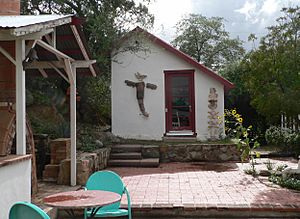
In 2000, Oracle had 3,563 people. By 2020, the population was 3,051. The average age of people living in Oracle in 2000 was 40 years old. About 26% of the population was under 18 years old.
See also
 In Spanish: Oracle (Arizona) para niños
In Spanish: Oracle (Arizona) para niños



